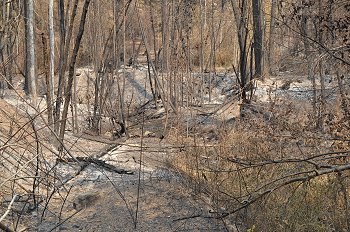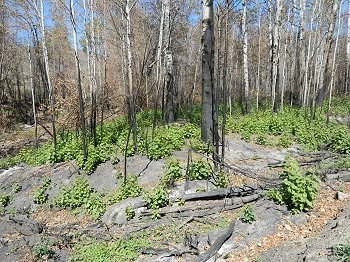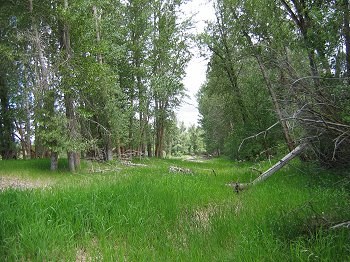Managing Forest Riparian Areas for Fire
Many people have been wondering what they should do to address fuel reduction in their riparian areas. During the 2014 Carlton Complex Fire, riparian zones experienced intensive burning and were corridors for fire spread. It is important to understand that the character of the Carlton Complex Fire was very different from what our community has experienced in past decades. The combination of the extremely dry weather and above average temperatures prior to the fires, and then the intense wind during the event, manifested itself in a fire with unpredictable behavior that didn’t follow most models.

Riparian areas by definition are in and around water sources, and riparian vegetation is dependent on moisture. Live trees, such as aspen, cottonwood and willows that are found in these ecosystems have high levels of moisture in their leaves and branches. Although live deciduous shrubs and trees may be top-killed by even low-intensity surface fires, they do not generally add to the actual flaming, or energy of the fire. Historically riparian areas experienced fires on the same frequency as upland areas, but they were quick to recover because of the availability of moisture. With the exclusion of fire to these areas, dead fuels accumulate and can contribute to fire hazard.

Landowners may wonder how this translates into their stewardship of riparian areas on their property. The Methow Conservancy recommends that landowners should leave all live aspen, cottonwood and willow trees on their property and NOT cut them down to reduce fire hazards. These riparian zones provide critical wildlife habitat, support a high level of biodiversity in our valley, and shade the rivers and streams (thereby reducing water temperatures for salmon and other aquatic populations). If, however, there is a lot of dead material in a particular area, be it branches, standing dead or fallen dead trees, land owners should consider removing some of the dead material -- piling it and ultimately burning it in a safe place under safe conditions or chipping it. To the degree that this can be done by hand, it is much preferable. Utilizing machinery in riparian zones can compact soils, create erosion and damage healthy vegetation. Thinning, pruning, or trimming of coniferous trees in riparian areas may also be desired if they are competing with deciduous trees or creating ladder fuels that could contribute to a crown fire.

The following considerations should be taken into account when removing dead material and other fuels in riparian areas:
- Remove weeds to the degree possible. Weeds can outcompete the native species that retain moisture. Although weed management should be conducted throughout the riparian areas, methods of removal should be minimally invasive and not harmful to surrounding vegetation or water bodies. If any herbicides are used in the riparian zone, they should be approved for use in and around water bodies.
- Leave any dead wood in streams or rivers unless it creates a risk for flooding or blocks the path of migratory fish.
- Refrain from removing dead wood and snags from within 25 feet of the water’s edge, unless there is immediate risk to homes or infrastructure. This wood can provide important habitat elements while it is standing and after it falls in the river or stream.
- Try to keep a balance between live trees, snags, and dead fall or woody debris. Keeping at least three snags and a similar number of fallen or downed trees per acre is recommended. Provide a variety of species and sizes of these remaining woody elements, and leave any downed or standing dead over 18” dbh in place. The ecological benefits of both snags and dead fall are very important to the health of the forest stand and the species that inhabit them.
Thinning, pruning or trimming of coniferous trees in riparian areas should be done with great caution, as these areas are at the same time highly productive and extremely vulnerable. The following recommendations should be considered when managing riparian vegetation:
- Minimize the site disturbance and footprint by using the least intrusive tools and avoiding steep slopes.
- Do not remove live deciduous riparian vegetation. These plants help to retain moisture in the stand and minimize erosion and sedimentation.
- Maintain waterside shade. This can be largely accomplished by maintaining a 25 foot zone of unmanaged vegetation.
- Maintain habitat diversity through leaving a variety of structural elements, species, and age classes.
For additional information about restoration of riparian areas, please email or call us at 509-996-2870.